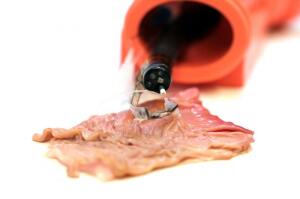by
Lauren Dubinsky, Senior Reporter | August 04, 2017

Soft pop-up arm performing tissue
counter-traction during an
ex-vivo test on a porcine stomach
Courtesy of Harvard
Harvard University researchers developed a soft, pop-up robotic arm for endoscopic surgery that could one day replace standard flexible endoscopes.
"These devices will be able to safely interact with body structures once at the surgical target, apply the necessary forces to successfully perform a surgical task, and provide the surgeons with crucial information exploiting onboard sensing," Dr. Sheila Russo, lead author of the research published in
Advanced Materials Technologies, told HCB News.
The arm was constructed using a manufacturing paradigm based on pop-up fabrication and soft lithography. It lies flat on the endoscope until it arrives at the target spot and then pops up.



Ad Statistics
Times Displayed: 2157
Times Visited: 29 Keep biomedical devices ready to go, so care teams can be ready to care for patients. GE HealthCare’s ReadySee™ helps overcome frustrations due to lack of network and device visibility, manual troubleshooting, and downtime.
Soft robots are safe to use for surgical applications because they won't accidentally puncture or tear tissue. But at small scales, they're not strong enough to perform surgical tasks.
To overcome that challenge, Russo and her team created a hybrid model of a rigid skeleton surrounded by soft materials. This was inspired by previous research involving origami-inspired, pop-up fabrication developed by Robert Wood of Charles River Laboratories.
Other pop-up manufacturing techniques are based on actuation methods that require high voltages or temperatures to operate. That would be a dangerous tool for directly manipulating biological tissues and organs.
The team integrated soft actuators into the pop-up system that are powered by water. They are attached to the rigid components with an irreversible chemical bond.
The robotic arm is capable of capacitive sensing and is also equipped with a suction cup so that it can safely interact with tissue.
"This system can be integrated on top of endoscopes without disrupting the current surgical workflow," said Russo. "It allows for endoluminal tissue manipulation, thus simplifying challenging procedures, such as endoscopic removal of early stage cancer."
The team was able to demonstrate that it can be used to measure forced applied to the tissue and provide surgeons with a sense of where the arm is and how it's moving.
They also tested the device on pig tissue to simulate a complicated endoscopic procedure. The arm manipulated the tissue successfully and safely.
Russo hopes that the arm can be used in the future as a disposable device in the operating room, considering that the manufacturing paradigm she developed is cost-effective.
"We are planning to continue testing this prototype, and our next step will be focused on in vivo trials," she added. "Of course, there is still some work to be done to bring this technology to patients, but results are very promising. "
Back to HCB News

